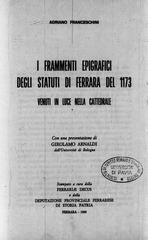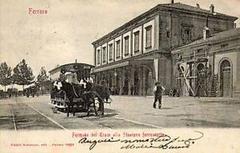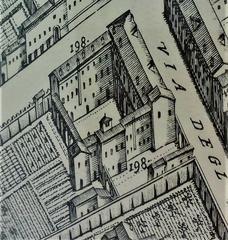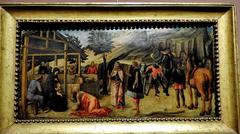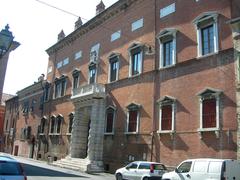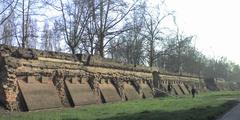
Ferrara Cathedral: Visiting Hours, Tickets, and Historical Sites Guide
Date: 14/06/2025
Introduction to Ferrara Cathedral’s Significance
Ferrara Cathedral, officially known as Basilica Cattedrale di San Giorgio, is a magnificent emblem of Ferrara’s rich history, religious tradition, and architectural splendor. Located in the heart of Ferrara’s UNESCO World Heritage historic center, the cathedral has stood as a pivotal landmark since its construction began in 1135. Dedicated to Saint George, the patron saint of Ferrara, the cathedral is a remarkable tapestry of Romanesque solidity, Gothic artistry, Renaissance innovation, and Baroque grandeur. Over centuries, it has evolved into a central place of worship, a civic gathering spot, and a showcase of some of northern Italy’s finest religious art (Wikiwand; Summer in Italy).
Beyond its architectural beauty—accentuated by its iconic tricuspidate façade and the legendary relief of Saint George slaying the dragon—Ferrara Cathedral is a living monument. Inside, visitors find a harmonious blend of medieval frescoes, Baroque ornamentation, and masterworks by artists such as Cosmè Tura and Guercino. The adjacent Museo della Cattedrale deepens the experience, housing sculptures, liturgical artifacts, and interactive exhibits that illuminate Ferrara’s religious art history (Catholic Shrine Basilica; Triplyzer).
This guide offers comprehensive details on Ferrara Cathedral’s visiting hours, ticketing, accessibility, and nearby attractions, as well as tips for making the most of your visit. Whether you are a pilgrim, a history enthusiast, or a cultural explorer, Ferrara Cathedral promises a richly layered journey through Italy’s medieval and Renaissance past (People Are Culture; The Crazy Tourist).
Table of Contents
- Discover Ferrara Cathedral: Historical Overview
- Architectural Features: Exterior and Interior
- Visiting Information: Hours, Tickets, Accessibility
- Nearby Attractions & Recommended Itinerary
- Cultural and Religious Significance
- Artistic Heritage & Museo della Cattedrale
- Practical Tips & FAQs
- Summary Table: Key Visitor Information
- References and Further Reading
Discover Ferrara Cathedral: Historical Overview
Origins and Early Construction
The construction of Ferrara Cathedral began in 1135, with a dedication to Saint George. Its Romanesque roots are evident in the sturdy stonework and rounded arches, designed to convey solidity and grandeur. Situated near the Palazzo Comunale and Castello Estense, the cathedral has always been central to the city’s religious and civic life.
Architectural Evolution
In the 13th century, Gothic influences reshaped the cathedral, especially the upper western façade’s pointed arches and arcades. The tricuspidate (three-gabled) façade and the main portal—attributed to the master sculptor Nicholaus—feature the dramatic relief of Saint George, surrounded by biblical figures and a Last Judgment scene.
Renaissance & Baroque Transformation
The Este family’s patronage during the 15th and 16th centuries brought Renaissance and Baroque elements. The marble campanile, begun in 1412 (possibly by Leon Battista Alberti), remains incomplete but striking. After an 18th-century fire, the cathedral’s interior was rebuilt in Baroque style, introducing ornate stuccoes, gilding, and frescoes.
Restoration and Resilience
The cathedral has weathered earthquakes, including the significant 2012 event. A major restoration began in 2018, focusing on both structural integrity and artistic preservation. The cathedral reopened in March 2024, even as restoration on the façade continues (Inferrara).
Architectural Features: Exterior and Interior
Exterior: Façade, Portals, and Bell Tower
- Façade: The west façade exemplifies the transition from Romanesque to Gothic, with its arcades, loggias, and rose windows (Wikiwand). The main portal’s lunette shows Saint George defeating the dragon, and the gallery above displays late Gothic statuary.
- Portals: Originally, the cathedral had a second, now-demolished portal on the south side. Decorative griffins and other sculptures from this portal are preserved in the piazza and museum.
- Bell Tower: The Renaissance bell tower, attributed to Leon Battista Alberti, features alternating bands of white and pink marble and remains a central element of Ferrara’s skyline (Catholic Shrine Basilica).
Interior: Nave, Transepts, and Artistic Treasures
- Nave and Transepts: The Baroque transformation after the 18th-century fire gives the interior grandeur, with three naves and a triple transept (Catholic Shrine Basilica). The high altar, consecrated in 1728, incorporates marble from Ravenna.
- Artistic Highlights: The cathedral houses monumental statues of Saints George and Maurelio, bronze works by Niccolò Baroncelli, and paintings by Guercino, Il Garofalo, Francesco Francia, and Bastianino (who painted the Last Judgement in the choir).
- Tombs: Pope Urban III’s tomb lies left of the high altar, underscoring the cathedral’s papal importance.
Visiting Information: Hours, Tickets, Accessibility
- Opening Hours: Daily, 9:00 AM to 6:00 PM (last entry at 5:30 PM). Closed from noon to 3:00 PM for lunch.
- Admission: Entry is free for worshippers; sightseeing tickets are approximately €5. Reduced rates available for students and children. Combined tickets for the Museo della Cattedrale and other sites are offered.
- Where to Buy: Purchase tickets at the entrance or online via official tourism websites.
- Accessibility: Wheelchair access is available at the main entrance. Some areas have steps or uneven floors; staff assistance is offered.
- Guided Tours: Available daily in multiple languages; booking in advance is recommended.
- Visitor Guidelines: Modest dress required. Photography allowed without flash, but silence and respect are expected during services.
Nearby Attractions & Recommended Itinerary
- Castello Estense: A moated Renaissance castle with museums and gardens, just steps away.
- Palazzo Comunale: Ferrara’s historic town hall.
- Cathedral Museum (Museo della Cattedrale): Across the piazza, it preserves original sculptures, manuscripts, and tapestries (Wikiwand).
- Palazzo dei Diamanti: Renowned for its unique façade and art exhibitions (TraveltoItalyGuide).
- Jewish Quarter: A testament to Ferrara’s tradition of religious coexistence.
A recommended itinerary: Visit the cathedral in the morning, tour the museum midday, and explore Castello Estense in the afternoon.
Cultural and Religious Significance
As the seat of the Archdiocese of Ferrara-Comacchio, the cathedral remains a vital site for liturgical celebrations, diocesan events, and religious festivals (Summer in Italy). The façade’s relief of Saint George embodies the city’s spiritual identity, while the interior’s art and monuments narrate centuries of devotion and patronage.
Artistic Heritage & Museo della Cattedrale
The Museo della Cattedrale, housed in a former church across the piazza, expands on the cathedral’s artistic story. Its collection features:
- 13th-century wall panels
- Illuminated hymnbooks
- Liturgical vestments
- Paintings and sculptures by local masters
Combined tickets often include museum entry, making it a must for those interested in Ferrara’s religious art (Triplyzer).
Practical Tips & FAQs
Practical Tips
- Dress Code: Shoulders and knees should be covered.
- Best Times: Early mornings or late afternoons offer a quieter experience and better light for photography.
- Photography: Non-flash photography is generally allowed, but be discreet during services.
- Amenities: Cafes, shops, and tourist information are located in the surrounding piazza.
Frequently Asked Questions
Q: What are the Ferrara Cathedral visiting hours?
A: Daily, 9:00 AM to 6:00 PM (last entry 5:30 PM), with a lunch closure from noon to 3:00 PM.
Q: How much are tickets?
A: €5 for adults for sightseeing; free for worshippers. Reductions for children and students; combined tickets available.
Q: Is the cathedral accessible for wheelchair users?
A: Yes, with some limitations due to historic architecture. Assistance is available.
Q: Are guided tours available?
A: Yes, in several languages. Booking ahead is advised.
Q: Can I take photos inside?
A: Yes, but without flash and not during services.
Summary Table: Key Visitor Information
| Aspect | Details |
|---|---|
| Location | Piazza Trento e Trieste, Ferrara, Italy |
| Opening Hours | Daily, 9:00 AM–6:00 PM; closed noon–3:00 PM |
| Admission | Free for worship; €5 sightseeing; museum has a separate fee |
| Dress Code | Modest attire required |
| Accessibility | Partial (ramps at entrance, some uneven floors inside) |
| Photography | Allowed (no flash, be respectful) |
| Guided Tours | Available, book in advance |
| Nearby Attractions | Castello Estense, Museo della Cattedrale, Palazzo dei Diamanti |
| Events | Ferrara Palio, St. George’s Feast, religious festivals |
| Amenities | Cafes, shops, tourist information nearby |
References and Further Reading
- Ferrara Cathedral: History, Architecture, and Essential Visiting Information, 2025 (Wikiwand)
- Ferrara Cathedral Visiting Hours, Tickets, and Architectural Highlights, 2025 (Catholic Shrine Basilica)
- Ferrara Cathedral Visiting Hours, Tickets, and Historical Significance: Your Complete Guide, 2025 (Summer in Italy)
- Ferrara Cathedral Visiting Hours, Tickets, and Guide to Ferrara’s Historic Landmark, 2025 (The Crazy Tourist)
- People Are Culture
- Triplyzer
- Inferrara
- Shego Wandering
- TraveltoItalyGuide
- Not Your Mama’s Italy
- Travel Editions
- Italia.it
- Visit Ferrara
- The Travel Folk
